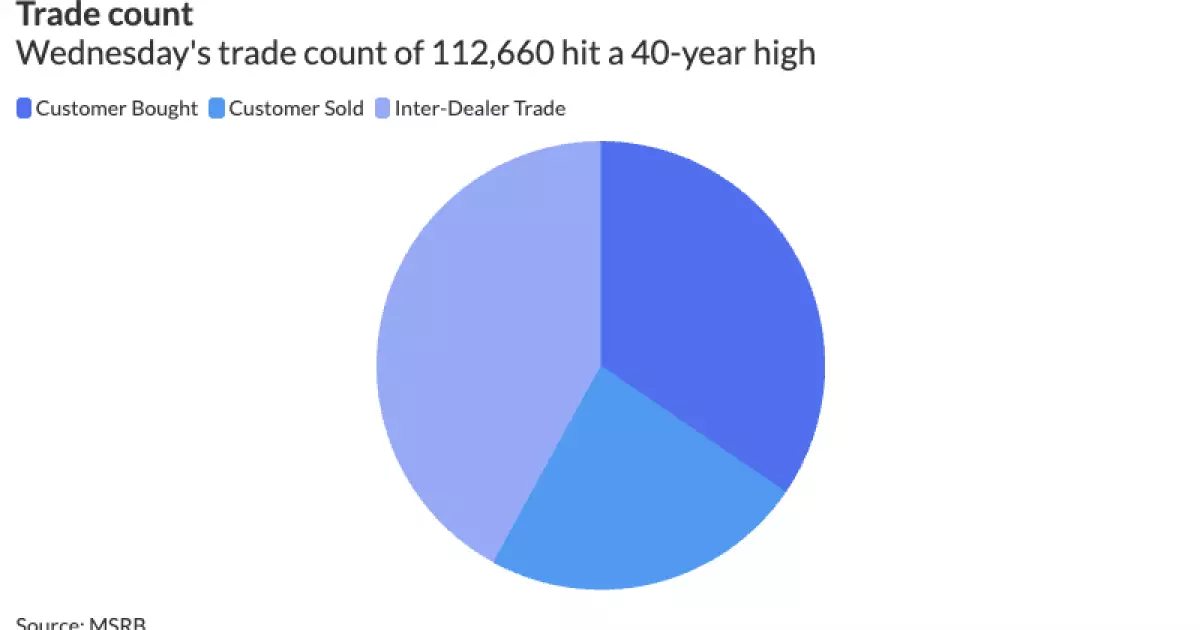The municipal bond market is no stranger to volatility. As observed recently, a significant rally occurred following President Trump’s announcement of a temporary halt on his tariff plans, which sent AAA yields plummeting. The magnitude of the decline was marked—between 30 to 50 basis points across the yield curves—only to amplify the already precarious state of the market. What should be a beacon of stability is quickly becoming a landscape of upheaval, reminiscent of the chaotic fluctuations that defined March 2020 during the initial phases of the pandemic.
Investors are keen to understand what lies beneath these transient fluctuations. The municipal market has seen its worst one-day performances in decades, and this recent spike indicates more than just a temporary bout of optimism; it could be symptomatic of underlying systemic issues. When the market experiences such severe swings, one must ask—are we witnessing a genuine rally or merely a temporary reprieve before another plunge? Analyzing these movements indicates a complex interplay of external pressures and investor sentiment that ultimately reveal more disquiet than reassurance.
Market Liquidity: A Growing Concern
One cannot overlook the alarming commentary from industry leaders regarding market liquidity. The last few days of trading have thrown the liquidity of the municipal bond market into disarray. Financial officers from major firms noted scenarios where selling bonds became an impossibility—an unnerving situation for an asset class that thrives on a constant flow of transactions. This volatility creates an ecosystem where trust dwindles, and investors become increasingly hesitant to take on positions.
With record-high trading volumes being reported, the disparity between actual market activity and healthy liquidity raises legitimate concerns. If the ability to buy or sell bonds hinges precariously on fleeting external announcements, what does that mean for long-term investments? Investors must ponder the risk of entering a tumultuous market where even a whisper of bad news could spark a wildfire of panic selling.
The Dismal Technical Environment
Further compounding these issues is the concerning technical environment surrounding municipal bonds. Despite the recent volatility attributed to the tariff announcement, the reality remains that the technical underpinnings of this market are weak. Even the positive fluctuations in yields mask deeper issues, such as an oversupply of bonds and the persistent pressure of upward movement in interest rates. Market dynamics have shifted dramatically, and the usual forces of demand and supply are not aligning favorably for buyers.
Despite a glimmer of hope following the tariff news, a concerning number of bonds are postponed or repositioned on daily calendars, suggesting a struggle to keep the momentum alive. The reality of mounting redemptions, maturing bonds, and coupon payments looms ominously, further complicating an already intricate situation.
The Uncertain Future of Municipal Investments
Investors who typically view municipal bonds as a safe haven may need to recalibrate their expectations. Financial experts are cautious, citing that until June, the prospects for recovery appear bleak. Investors are urged to maintain vigilance during this unpredictable period, especially since bidding activity remains elevated, hinting at a market still fraught with anxiety and uncertainty.
The specter of an economic downturn continues to hang over municipal bonds, pushing investors to reconsider their positions closely. The reality of rising financial pressures and declining liquidity is compounded by the overhanging fear of external impacts—like tariffs or inflation—that can quickly shift the market sentiment from cautious optimism to sheer panic.
Implications for the Broader Economy
The challenges faced by municipal bonds do not exist in a vacuum. A shaky bond market can lead to far-reaching ramifications for the broader economy. Municipal bonds often finance essential services and infrastructure, which means disruptions in the market could impact public funding, further limiting economic growth.
Investors must remain vigilant, as the negative pressure on the municipal bond market can act as a barometer for overall economic health. The chaos of today may be a precursor for tomorrow’s financial climate. If there’s a lesson to be learned from this upheaval, it’s that the dynamics of the municipal bond market can mirror broader economic trends, serving as a warning signal in an ever-changing financial landscape.
In the face of such precarious conditions, maintaining a clear-eyed view of the market is more essential than ever. Investors must prepare for continued volatility and either adapt or risk getting swept away in the tide of the often capricious municipal bond market.

